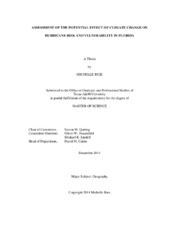| dc.description.abstract | Hurricanes are a yearly threat to the eastern and Gulf coasts of the United States. An increase in frequency and intensity of hurricanes is a possible and dangerous consequence of future climate change. To assess the threat of more frequent and intense hurricanes, this research will address how climate change will affect future hurricane activity in Florida. A greater understanding of how climate change will affect hurricanes is vital for regions, such as Florida, that are vulnerable to these powerful storms.
Hurricane return periods were calculated for all Florida counties based on 1900-2010. Hurricane landfalls were quantified using a dynamic wind model which allowed for the spatial extent of each storm to be examined. A meta-analysis of the existing literature on the effects of climate change on hurricane behavior was performed. Using the findings from the meta-analysis, a sensitivity analysis was performed to determine how climate change may affect hurricane damage and loss for Florida. The HAZUS-MH Hurricane Model was used to estimate losses and damage from hurricane winds based on Florida’s growing population and increasing coastal development.
Results show that wind-derived return periods more accurately depict the distribution of a storm’s wind field. Counties in southern Florida have the lowest return periods based on the track-derived and wind-derived return periods. Based on the meta-analysis, hurricane intensity is expected to increase by 2 to 11%. Hurricane frequency is expected to decrease or remain the same and storm tracks are not expected to change. The sensitivity analysis examined the influence of climate change on baseline (current), moderate (15% increase), and extreme (35% increase) TC intensity scenarios. The most developed and populated regions are the most vulnerable to hurricane damages and losses. Based on the boxplots, the spread of percent values increases for building damage, economic losses, and shelter needs as storm intensity increases. The spread in the data shown in the scatterplots and boxplots is storm specific. This research found that southeastern Florida is at highest risk of future hurricane landfalls and most vulnerable to hurricane damages and losses. | en |


